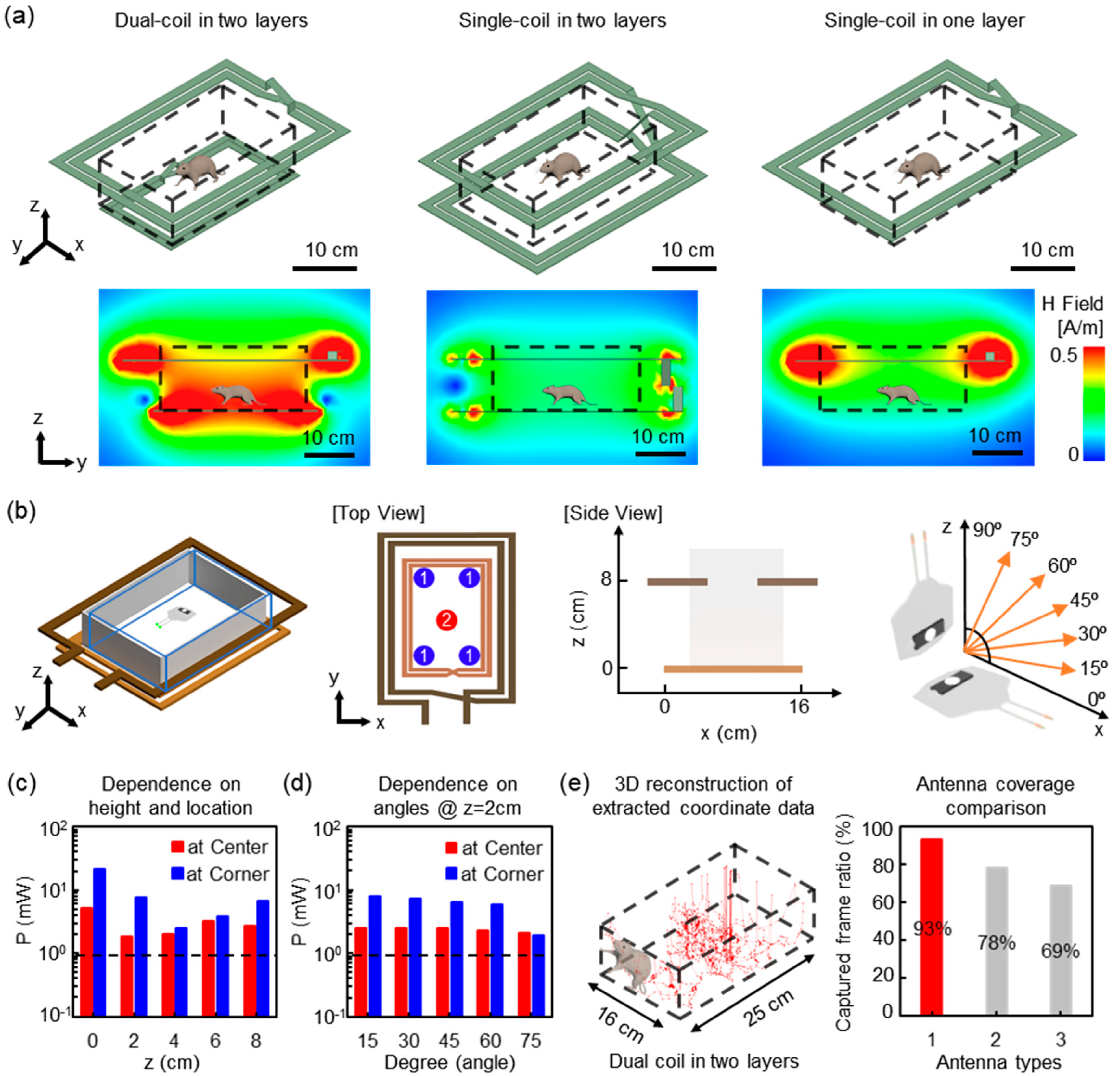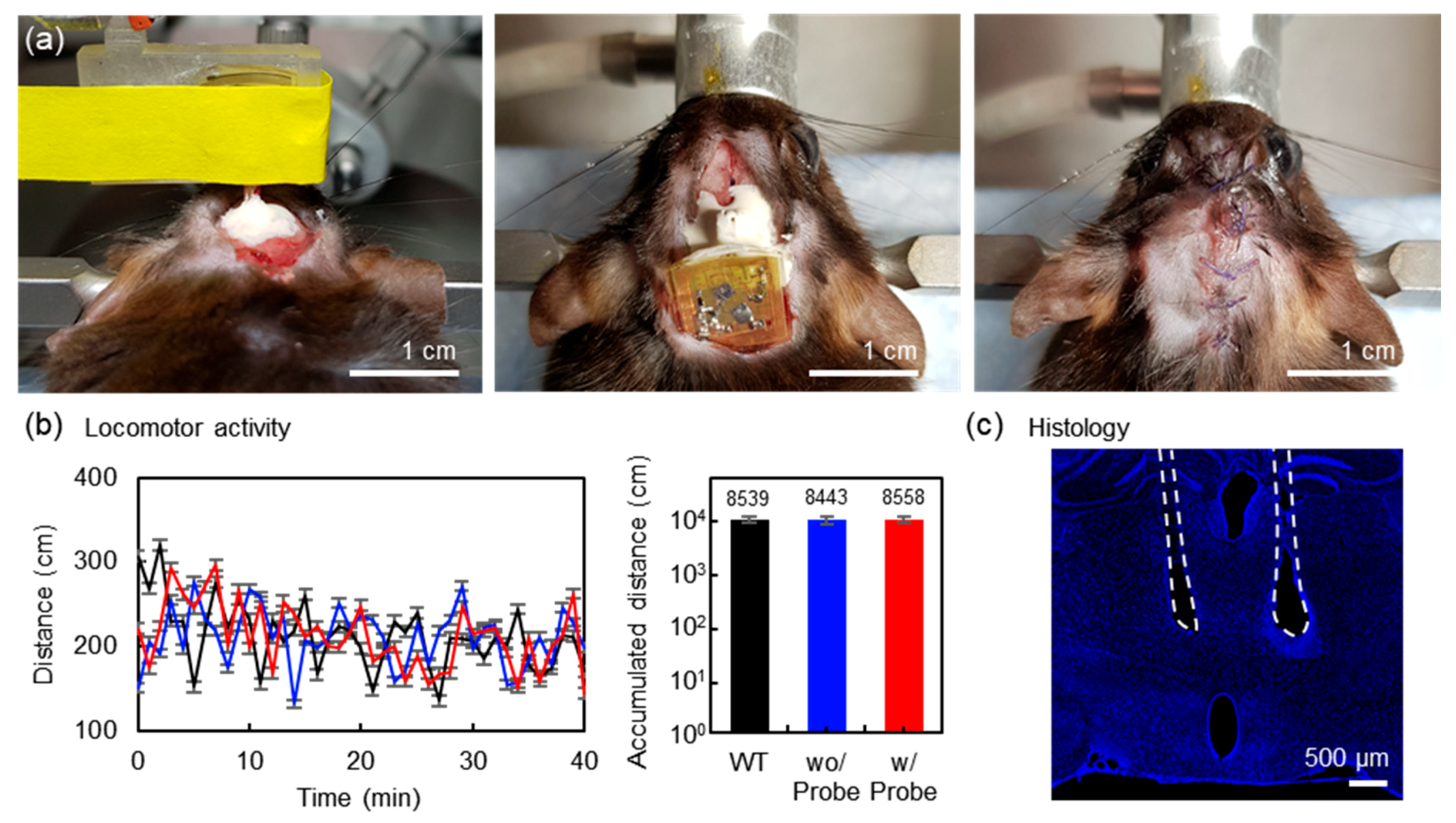Fully Implantable Low-Power High Frequency Range Optoelectronic Devices for Dual-Channel Modulation in the Brain
Abstract
1. Introduction
2. Materials and Methods
2.1. Device Fabrication
2.2. Actuation Mechanisms by a Magnet
2.3. Actuation Mechanisms by a Radio-Frequency Signal
2.4. Finite Element Analysis
2.5. The Coverage Measurements of the Wireless Power TX System
2.6. Procedures for Device Implantation and Sham Study
2.7. Measurements of Durability and Heat Dissipation
3. Results
3.1. Low-Power, Magnet Induced Dual-Channel Optoelectronic Device
3.2. Magnet-Free, Dual-Channel Optoelectronic Device
3.3. Wireless Coverage
3.4. Sham Study
4. Discussion
5. Conclusions
Supplementary Materials
Author Contributions
Funding
Acknowledgments
Conflicts of Interest
References
- Fenno, L.; Yizhar, O.; Deisseroth, K. The development and application of optogenetics. Annu. Rev. Neurosci. 2011, 34, 389–412. [Google Scholar] [CrossRef] [PubMed]
- Deisseroth, K. Optogenetics: 10 years of microbial opsins in neuroscience. Nat. Neurosci. 2015, 18, 1213–1225. [Google Scholar] [CrossRef] [PubMed]
- Yizhar, O.; Fenno, L.E.; Davidson, T.J.; Mogri, M.; Deisseroth, K. Optogenetics in Neural Systems. Neuron 2011, 71, 9–34. [Google Scholar] [CrossRef] [PubMed]
- Iyer, S.; Montgomery, K.L.; Towne, C.; Lee, S.Y.; Ramakrishnan, C.; Deisseroth, K.; Delp, S. Virally mediated optogenetic excitation and inhibition of pain in freely moving nontransgenic mice. Nat. Biotechnol. 2014, 32, 274–278. [Google Scholar] [CrossRef]
- Liske, H.; Towne, C.; Anikeeva, P.; Zhao, S.; Feng, G.; Deisseroth, K.; Delp, S. Optical inhibition of motor nerve and muscle activity in vivo. Muscle Nerve 2013, 47, 916–921. [Google Scholar] [CrossRef]
- Montgomery, K.L.; Yeh, A.J.; Ho, J.S.; Tsao, V.; Iyer, S.; Grosenick, L.; A Ferenczi, E.; Tanabe, Y.; Deisseroth, K.; Delp, S.L.; et al. Wirelessly powered, fully internal optogenetics for brain, spinal and peripheral circuits in mice. Nat. Methods 2015, 12, 969–974. [Google Scholar] [CrossRef] [PubMed]
- Adamantidis, A.; Zhang, F.; Aravanis, A.M.; Deisseroth, K.; De Lecea, L. Neural substrates of awakening probed with optogenetic control of hypocretin neurons. Nature 2007, 450, 420–424. [Google Scholar] [CrossRef]
- Park, S.I.; Brenner, D.S.; Shin, G.; Morgan, C.; Copits, B.A.; Chung, H.U.; Pullen, M.Y.; Noh, K.N.; Davidson, S.; Oh, S.J.; et al. Soft, stretchable, fully implantable miniaturized optoelectronic systems for wireless optogenetics. Nat. Biotechnol. 2015, 33, 1280–1286. [Google Scholar] [CrossRef]
- Siuda, E.R.; McCall, J.G.; Al-Hasani, R.; Shin, G.; Park, S.I.; Schmidt, M.J.; Anderson, S.L.; Planer, W.J.; Rogers, J.A.; Bruchas, M.R. Optodynamic simulation of β-adrenergic receptor signalling. Nat. Commun. 2015, 6, 8480. [Google Scholar] [CrossRef]
- Shin, G.; Gomez, A.; Al-Hasani, R.; Jeong, Y.R.; Kim, J.; Xie, Z.; Banks, A.; Lee, S.M.; Han, S.Y.; Yoo, C.J.; et al. Flexible Near-Field Wireless Optoelectronics as Subdermal Implants for Broad Applications in Optogenetics. Neuron 2017, 93, 509–521.e3. [Google Scholar] [CrossRef]
- Park, S.I.; Shin, G.; Banks, A.; McCall, J.G.; Siuda, E.R.; Schmidt, M.J.; Chung, H.U.; Noh, K.N.; Mun, J.G.-H.; Rhodes, J.; et al. Ultraminiaturized photovoltaic and radio frequency powered optoelectronic systems for wireless optogenetics. J. Neural Eng. 2015, 12, 056002. [Google Scholar] [CrossRef] [PubMed]
- Park, S.I.; Shin, G.; McCall, J.G.; Al-Hasani, R.; Norris, A.; Xia, L.; Brenner, D.S.; Noh, K.N.; Bang, S.Y.; Bhatti, D.L.; et al. Stretchable multichannel antennas in soft wireless optoelectronic implants for optogenetics. Proc. Natl. Acad. Sci. USA 2016, 113, E8169–E8177. [Google Scholar] [CrossRef]
- Kim, T.; McCall, J.G.; Jung, Y.H.; Huang, X.; Siuda, E.R.; Li, Y.; Song, J.; Song, Y.M.; Pao, H.A.; Kim, R.-H.; et al. Injectable, Cellular-Scale Optoelectronics with Applications for Wireless Optogenetics. Science 2013, 340, 211–216. [Google Scholar] [CrossRef] [PubMed]
- Zhang, Y.; Mickle, A.D.; Gutruf, P.; McIlvried, L.A.; Guo, H.; Wu, Y.; Golden, J.P.; Xue, Y.; Grajales-Reyes, J.G.; Wang, X.; et al. Battery-free, fully implantable optofluidic cuff system for wireless optogenetic and pharmacological neuromodulation of peripheral nerves. Sci. Adv. 2019, 5, eaaw5296. [Google Scholar] [CrossRef]
- Mayer, P.; Sivakumar, N.; Pritz, M.; Varga, M.; Mehmann, A.; Lee, S.; Salvatore, A.; Magno, M.; Pharr, M.; Johannssen, H.C.; et al. Flexible and Lightweight Devices for Wireless Multi-Color Optogenetic Experiments Controllable via Commercial Cell Phones. Front. Mol. Neurosci. 2019, 13, 819. [Google Scholar] [CrossRef]
- Mickle, A.D.; Won, S.M.; Noh, K.N.; Yoon, J.; Meacham, K.W.; Xue, Y.; McIlvried, L.A.; Copits, B.A.; Samineni, V.K.; Crawford, K.E.; et al. A wireless closed-loop system for optogenetic peripheral neuromodulation. Nature 2019, 565, 361–365. [Google Scholar] [CrossRef] [PubMed]
- 8-Bit Microcontroller with 2K/4K/8K Bytes in-System Programmable Flash. Available online: http://ww1.microchip.com/downloads/en/devicedoc/8183s.pdf (accessed on 28 June 2020).
- Kinetis KL03 32 KB Flash 48 MHz Cortex-M0+ Based Microcontroller. Available online: https://www.nxp.com/docs/en/data-sheet/KL03P24M48SF0.pdf (accessed on 28 June 2020).
- M24LR16E-R Dynamic NFC/RFID Tag IC with 16-Kbit EEPROM, Energy Harvesting, I²C Bus and ISO 15693 RF Interface. Available online: https://www.sekorm.com/doc/786414.html (accessed on 28 June 2020).
- nRF51822 Product Specification v3.1. Available online: https://infocenter.nordicsemi.com/pdf/nRF51822_PS_v3.1.pdf (accessed on 28 June 2020).
- Bailey, W.H.; Bodemann, R.; Bushberg, J.; Chou, C.K.; Cleveland, R.; Faraone, A.; Foster, K.R.; Gettman, K.E.; Graf, K.; Harrington, T.; et al. Synopsis of IEEE Std C95.1TM-2019 IEEE Standard for Safety Levels With Respect to Human Exposure to Electric, Magnetic, and Electromagnetic Fields, 0 Hz to 300 GHz. IEEE Access 2019, 7, 171346–171356. [Google Scholar] [CrossRef]
- Kodera, S.; Hirata, A. Comparison of Thermal Response for RF Exposure in Human and Rat Models. Int. J. Environ. Res. Public Health 2018, 15, 2320. [Google Scholar] [CrossRef]
- Kim, W.S.; Hong, S.; Morgan, C.; Smith, K.A.; Lawton, M.T.; Park, S.I. A Soft, Biocompatible Magnetic Field Enabled Wireless Surgical Lighting Patty for Neurosurgery. Appl. Sci. 2020, 10, 2001. [Google Scholar] [CrossRef]
- Montagni, E.; Resta, F.; Mascaro, A.L.A.; Pavone, F.S. Optogenetics in Brain Research: From a Strategy to Investigate Physiological Function to a Therapeutic Tool. Photonics 2019, 6, 92. [Google Scholar] [CrossRef]
- Caruso, M.J.; Bratland, T.; Smith, C.H.; Schneider, R. A new perspective on magnetic field sensing. Sensors 1998, 15, 34–46. [Google Scholar]
- Mankowski, J.; Kristiansen, M. A review of short pulse generator technology. IEEE Trans. Plasma Sci. 2000, 28, 102–108. [Google Scholar] [CrossRef]
- Yang, C.-L.; Yang, Y.-L.; Lo, C.-C. Subnanosecond Pulse Generators for Impulsive Wireless Power Transmission and Reception. IEEE Trans. Circuits Syst. II Express Briefs 2011, 58, 817–821. [Google Scholar] [CrossRef]
- Kurs, A.; Karalis, A.; Moffatt, R.; Joannopoulos, J.D.; Fisher, P.; Soljačic, M. Wireless Power Transfer via Strongly Coupled Magnetic Resonances. Science 2007, 317, 83–86. [Google Scholar] [CrossRef]
- Kiani, M.; Ghovanloo, M. The Circuit Theory Behind Coupled-Mode Magnetic Resonance-Based Wireless Power Transmission. IEEE Trans. Circuits Syst. I Regul. Pap. 2012, 59, 2065–2074. [Google Scholar] [CrossRef] [PubMed]
- Bercich, R.A.; Wang, Z.; Mei, H.; Hammer, L.H.; Seburn, K.L.; Hargrove, L.J.; Irazoqui, P.P. Enhancing the versatility of wireless biopotential acquisition for myoelectric prosthetic control. J. Neural Eng. 2016, 13, 46012. [Google Scholar] [CrossRef] [PubMed]
- Cannon, B.L.; Member, S.; Hoburg, J.F.; Stancil, D.D.; Goldstein, S.C.; Member, S. Magnetic Resonant Coupling As a Potential Means for Wireless Power Transfer to Multiple Small Receivers. IEEE Trans. Power Electron. 2009, 24, 1819–1825. [Google Scholar] [CrossRef]
- Gu, M.; Vorobiev, D.; Kim, W.S.; Chien, H.-T.; Woo, H.-M.; Hong, S.C.; Park, S.I. A Novel Approach Using an Inductive Loading to Lower the Resonant Frequency of a Mushroom-Shaped High Impedance Surface. Prog. Electromagn. Res. M 2020, 90, 19–26. [Google Scholar] [CrossRef]
- Ramrakhyani, A.K.; Mirabbasi, S.; Chiao, M. Design and Optimization of Resonance-Based Efficient Wireless Power Delivery Systems for Biomedical Implants. IEEE Trans. Biomed. Circuits Syst. 2010, 5, 48–63. [Google Scholar] [CrossRef]
- DeNardo, L.A.; Liu, C.D.; Allen, W.E.; Adams, E.L.; Friedmann, D.; Fu, L.; Guenthner, C.J.; Tessier-Lavigne, M.; Luo, L. Temporal evolution of cortical ensembles promoting remote memory retrieval. Nat. Neurosci. 2019, 22, 460–469. [Google Scholar] [CrossRef] [PubMed]
- Zhang, H.; Gutruf, P.; Meacham, K.; Montana, M.C.; Zhao, X.; Chiarelli, A.M.; Vázquez-Guardado, A.; Norris, A.; Lu, L.; Guo, Q.; et al. Wireless, battery-free optoelectronic systems as subdermal implants for local tissue oximetry. Sci. Adv. 2019, 5, eaaw0873. [Google Scholar] [CrossRef] [PubMed]
- Ma, T.; Cheng, Y.; Hellard, E.R.; Wang, X.; Lu, J.; Gao, X.; Huang, C.C.Y.; Wei, X.-Y.; Ji, J.-Y.; Wang, J. Bidirectional and long-lasting control of alcohol-seeking behavior by corticostriatal LTP and LTD. Nat. Neurosci. 2018, 21, 373–383. [Google Scholar] [CrossRef] [PubMed]
- Witten, I.B.; Steinberg, E.E.; Lee, S.Y.; Davidson, T.J.; Zalocusky, K.A.; Brodsky, M.; Yizhar, O.; Cho, S.L.; Gong, S.; Ramakrishnan, C.; et al. Recombinase-Driver Rat Lines: Tools, Techniques, and Optogenetic Application to Dopamine-Mediated Reinforcement. Neuron 2011, 72, 721–733. [Google Scholar] [CrossRef] [PubMed]





| Process | Purpose | Equipment/Tools (Model Name/Manufactures) | Progress 1 |
|---|---|---|---|
| 1. Preparation of Cu/PI film | Preparation of the films for defining patterns | PI/Cu film (AC181200R, DupontTM Pyralux®) glass Kapton tape | 5% |
| 2. UV photo-lithography | Define the patterns | Cleanroom (AggieFab) Spin-coater (G3 P-8, Specialty Coating Systems) Hotplate (SP88850200, Fisher ScientificTM) Mask aligner (EVG®610, EV Group) Photoresist (AZ 1518, AZ®) Developer (AZ Developer 1:1, AZ®) Copper etchant (Alfa Aesar™) | 30% |
| 3. Components soldering | Mount electrical components on the pattern | Microscope (SPZV 50E, AVEN) Solder cored wire flux (397952, Multicore®) Solder stations (WD1002/WP80, Weller) Stainless steel wire (75,000 psi tensile strength, and 0.008’’ diameter, McMaster-Carr) UV epoxy (MED-OG198-54, Epoxy Technology) | 60% |
| 4. 1st testing | Function verification | Transmit power system (FEIG electronic) Magnets | 70% |
| 5. PDMS encapsulation | Device packaging | Vacuum ovens (Accu Temp 1.9, AI) PDMS (SylgardTM 184 silicone elastomer kit, Dow®) | 95% |
| 6. 2nd testing | Device validation | Transmit power system (FEIG electronic) Magnets | 100% |
© 2020 by the authors. Licensee MDPI, Basel, Switzerland. This article is an open access article distributed under the terms and conditions of the Creative Commons Attribution (CC BY) license (http://creativecommons.org/licenses/by/4.0/).
Share and Cite
Kim, W.S.; Jeong, M.; Hong, S.; Lim, B.; Park, S.I. Fully Implantable Low-Power High Frequency Range Optoelectronic Devices for Dual-Channel Modulation in the Brain. Sensors 2020, 20, 3639. https://doi.org/10.3390/s20133639
Kim WS, Jeong M, Hong S, Lim B, Park SI. Fully Implantable Low-Power High Frequency Range Optoelectronic Devices for Dual-Channel Modulation in the Brain. Sensors. 2020; 20(13):3639. https://doi.org/10.3390/s20133639
Chicago/Turabian StyleKim, Woo Seok, Minju Jeong, Sungcheol Hong, Byungkook Lim, and Sung Il Park. 2020. "Fully Implantable Low-Power High Frequency Range Optoelectronic Devices for Dual-Channel Modulation in the Brain" Sensors 20, no. 13: 3639. https://doi.org/10.3390/s20133639
APA StyleKim, W. S., Jeong, M., Hong, S., Lim, B., & Park, S. I. (2020). Fully Implantable Low-Power High Frequency Range Optoelectronic Devices for Dual-Channel Modulation in the Brain. Sensors, 20(13), 3639. https://doi.org/10.3390/s20133639






